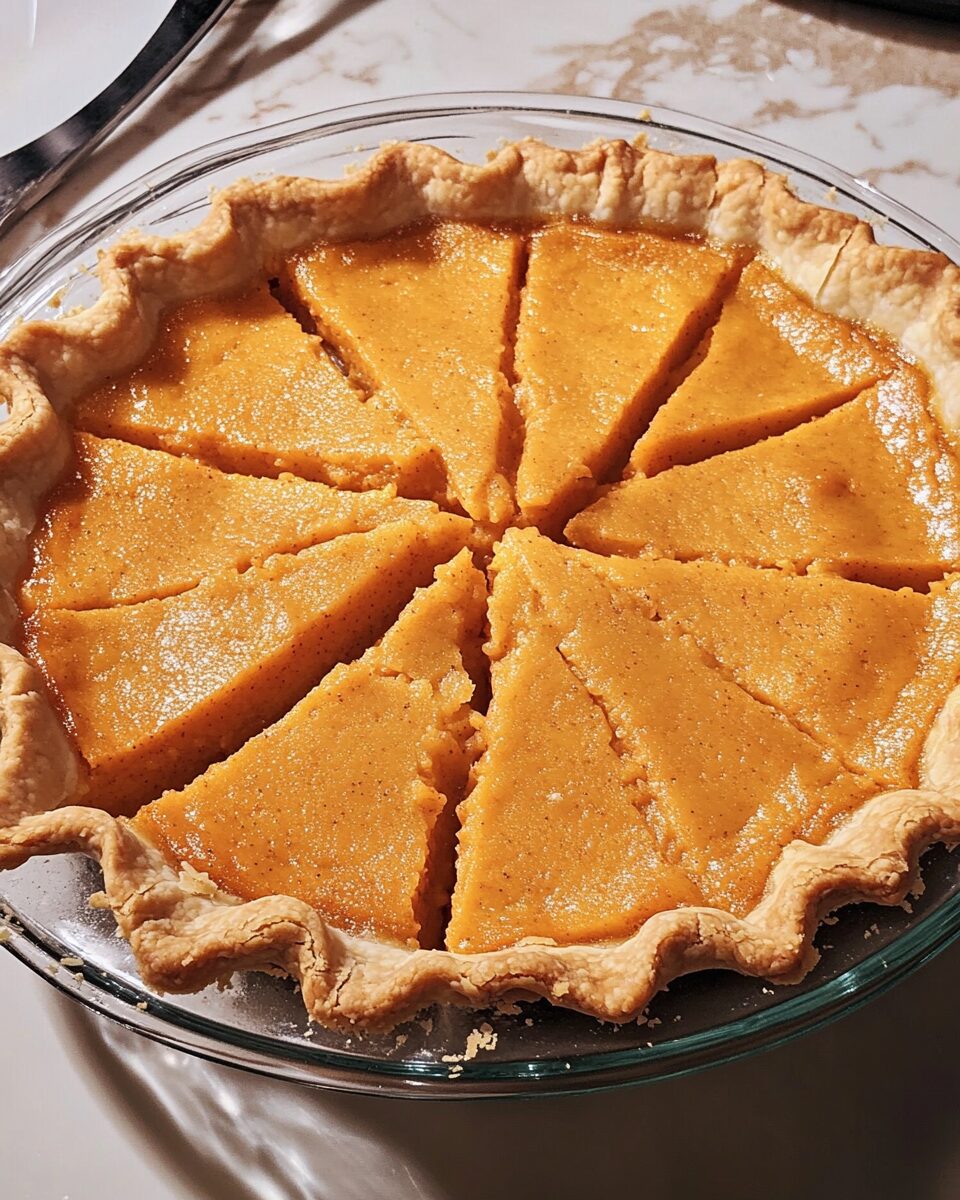The perfect blend of sweet, creamy, and spiced, this Sweet Potato Pie is a must-have for your holiday dessert spread. With its smooth texture and warm, cinnamon-nutmeg flavor, it’s the kind of dessert that instantly brings back cozy family memories.
This Southern classic is incredibly simple to make, yet delivers rich, nostalgic flavor in every bite. Whether you’re prepping for Thanksgiving, Sunday supper, or just craving a slice of comfort, this pie is sure to be a crowd favorite. Top it with a dollop of whipped cream and enjoy the taste of home.
Full recipe:
Ingredients:
-
1 lb sweet potatoes (about 2 medium), peeled and cubed
-
1 stick (1/2 cup) unsalted butter, melted
-
1 cup granulated sugar
-
1/2 cup whole milk
-
2 large eggs
-
1/2 teaspoon ground cinnamon
-
1/2 teaspoon ground nutmeg
-
1 teaspoon pure vanilla extract
-
1 (9-inch) unbaked pie crust
Directions:
-
Preheat oven to 350°F (175°C).
-
Place peeled, cubed sweet potatoes in a large pot and cover with water. Bring to a boil and cook until fork-tender, about 15 minutes. Drain and mash well.
-
In a large mixing bowl, combine the mashed sweet potatoes, melted butter, sugar, milk, eggs, cinnamon, nutmeg, and vanilla. Whisk until the mixture is smooth and creamy.
-
Pour the filling into the prepared pie crust and smooth the top with a spatula.
-
Bake for 55 to 60 minutes, or until the center is set and a toothpick inserted comes out clean.
-
Let cool completely before slicing. Serve with whipped cream if desired.
Prep Time: 20 minutes | Cooking Time: 60 minutes | Total Time: 1 hour 20 minutes
Kcal: 320 kcal | Servings: 8 servings
Cultural and Historical Significance
Sweet potato pie has its origins in West African traditions, where yams—closely related to sweet potatoes—were a dietary staple. Enslaved Africans in America adapted their familiar ingredients to those available in the New World, substituting sweet potatoes for yams and applying Old World cooking techniques. Over generations, sweet potato pie evolved into a distinctly Southern dish and became a fixture in African American cooking.
In Southern culture, food is more than sustenance; it’s a means of connection. Sweet potato pie, in particular, represents warmth, hospitality, and home. It appears at nearly every major holiday and is often served as a gesture of welcome and generosity. Its presence on the table is an expression of love and a testament to culinary resilience and creativity.
Why Sweet Potato Pie is Special
Sweet potato pie stands out among other desserts for its balance of flavors and textures. The naturally sweet and starchy nature of sweet potatoes gives the pie a dense yet creamy texture. When blended with butter, milk, eggs, and spices, the mixture becomes silky and luscious, with a flavor profile that’s deeper and earthier than pumpkin pie.
Additionally, sweet potato pie is more forgiving and adaptable than many other baked desserts. The filling doesn’t require elaborate techniques or special equipment, making it accessible for beginner bakers and seasoned pros alike. Its simplicity is part of its charm—requiring just a few ingredients and a little patience, it transforms into a dessert that feels both decadent and wholesome.
Flavor and Texture Profile
The pie’s texture is one of its standout features. The mashed sweet potatoes provide a dense and creamy base, while the added eggs and milk create a custard-like smoothness. Spices such as cinnamon and nutmeg add warmth and depth without overpowering the natural flavor of the sweet potatoes.
The crust, usually a traditional pastry crust, provides a pleasant contrast with its crispness and buttery flavor. Some bakers opt to add a touch of brown sugar or even pecans to the crust for extra dimension. Once baked, the pie has a beautiful golden hue, often with subtle browning on top, adding visual appeal to its already inviting aroma.
Occasions for Serving Sweet Potato Pie
Sweet potato pie is a staple during fall and winter holidays, particularly Thanksgiving and Christmas. Its autumnal flavor profile and warming spices make it a seasonal favorite. However, its popularity extends far beyond these events.
It’s also commonly served at family reunions, church picnics, potlucks, and other community gatherings. Because it holds up well at room temperature and travels easily, sweet potato pie is a go-to dessert for social occasions. Some families even enjoy it as a breakfast treat with coffee or as a late-night indulgence with a glass of milk.
Nutritional Perspective
Compared to many other dessert pies, sweet potato pie offers some surprising nutritional benefits. Sweet potatoes are high in fiber, beta-carotene (a precursor to vitamin A), vitamin C, potassium, and antioxidants. While the pie does include sugar and butter, it can still be considered a slightly healthier option among traditional desserts due to its nutrient-dense primary ingredient.
For health-conscious bakers, there are many ways to make sweet potato pie a bit lighter without compromising on flavor. Using less sugar, replacing whole milk with a dairy-free alternative, or using a gluten-free crust can tailor the recipe to various dietary needs.
Variations and Creative Twists
Though traditional sweet potato pie is hard to beat, there’s plenty of room for creativity. Some popular variations include:
-
Maple Sweet Potato Pie: Sweetened with maple syrup instead of granulated sugar for a rich, caramelized flavor.
-
Marshmallow-Topped Sweet Potato Pie: Similar to sweet potato casserole, a layer of toasted marshmallows can add visual flair and nostalgic flavor.
-
Pecan Crust or Topping: Adding chopped pecans to the crust or as a crumble topping gives a nice crunch and nutty contrast.
-
Vegan or Dairy-Free Versions: Coconut milk or almond milk can substitute for dairy, and flax eggs can replace regular eggs for a fully plant-based version.
-
Mini Sweet Potato Pies: Perfect for portion control or party-friendly serving, these can be made in muffin tins.
Tips for Perfect Sweet Potato Pie
-
Roast Instead of Boil: For deeper flavor and less moisture, roast the sweet potatoes instead of boiling them. This concentrates their sweetness and enhances texture.
-
Smooth Consistency: Puree the filling ingredients thoroughly for a silky texture. A food processor or blender can help eliminate lumps.
-
Don’t Overbake: The pie is done when the center just barely jiggles. Overbaking can lead to cracks or a rubbery texture.
-
Cool Completely: Allow the pie to cool at room temperature before slicing. This helps it set properly and enhances flavor.
Storage and Make-Ahead Options
Sweet potato pie is an excellent make-ahead dessert. It can be baked a day or two before serving and stored in the refrigerator. In fact, letting the pie rest overnight can improve its flavor and texture as the spices meld. Cover it tightly with plastic wrap or foil to keep it fresh.
To freeze, wrap the entire cooled pie in plastic and then in foil, and store it for up to 2 months. Thaw it in the refrigerator overnight before serving. Reheat gently in the oven to restore its original texture and warmth.
Sweet Potato Pie vs. Pumpkin Pie
Though they are often seen side by side during fall celebrations, sweet potato pie and pumpkin pie are distinctly different in both flavor and texture. Sweet potato pie is richer and denser with a natural sweetness and earthy flavor. Pumpkin pie, while also spiced, tends to be lighter and slightly more custardy, with a subtle bitterness from the squash.
Sweet potato pie is often preferred in Southern households, while pumpkin pie has become more popular in other parts of the U.S. Both are delicious, but sweet potato pie is prized for its bold flavor and cultural significance.
Conclusion
Sweet potato pie is more than a seasonal dessert—it’s a soulful, storied, and beloved dish that brings generations together. Whether served at a holiday table or enjoyed on a quiet Sunday afternoon, it delivers comfort, tradition, and flavor in every slice. Its legacy, rooted in African American history and Southern hospitality, continues to be celebrated and cherished in kitchens across the country.
As food trends come and go, sweet potato pie remains a timeless classic. Its simplicity, adaptability, and emotional resonance ensure that it will remain a staple for years to come. If you’ve never made it before, now is the perfect time to bring this comforting tradition into your own kitchen and create memories one slice at a time.






